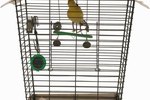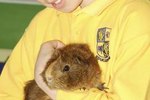
For those who want a bird with a large parrot's personality but not the noise, mess or expense, a parrotlet is an ideal choice. Parrotlets measure a mere 3 inches to 5 1/2 inches long. They don't have the ability to screech or scream, instead producing more of a chirp or tweet. With daily attention, they can become loving pets and, if well cared for, they can live 15 to 20 years.
One Is Best
While many birds enjoy having a cage companion, parrotlets are best kept singly. The pint-size cuties tend to be territorial and aggressive toward other birds of any kind. Parrotlets are active bundles of energy, so they need a cage that's large enough to move around and play -- at least 18 inches long by 18 inches wide by 24 inches tall. Bars should be spaced no farther than five-eighths of an inch apart so their little heads can't get stuck. Attach several natural wood perches at different heights, and perhaps one perch made of cement or sand to help keep nails trimmed.
Awake and Asleep
Parrotlets like to be around people, so place their cage in a quiet corner of a busy room. That way, the parrotlets feel like they're part of the action but aren't overwhelmed. Be sure the cage isn't in a drafty area or in direct sunlight. Parrotlets need 12 hours of sleep at night. Covering the cage at night will help them associate darkness with time to go to sleep.
Toys and Play Time
Parrotlets need lots of different types of toys in their cages, from ropes and chew toys and bells to ladders, rings and swings. They have very strong bills, so choose toys designed for cockatiels and conures rather than for parakeets. Be sure the toys are sturdy; avoid those with small or movable parts, wire or string. Check them regularly for small, loose pieces or worn areas. Parrotlets do enjoy time outside their cages, but they must be closely supervised at all times. Their curious, busy natures can get them into trouble through injury or ingesting something harmful, and they are often aggressive toward other pets.
Diet and Nutrition
In spite of their diminutive size, parrotlets need lots of nutritious food to fuel their active lifestyles. Offer food in open containers, because parrotlets won't put their heads into containers with tops. A healthy parrotlet diet should include seeds designed for cockatiels, plus a variety of fresh vegetables and fruit minced into bite-size pieces. Be sure to remove any leftover veggies or fruits within two hours so they don't spoil. Offer fresh water daily, and change the water if it becomes contaminated with seeds, food or other materials.
Talking and Tricks
Parrotlets are entertainers. Once they have bonded and become comfortable with their owners, they can be taught tricks. This requires a lot of patience and time, repeating each action over and over until the bird repeats it. As for talking, it's estimated that 80 percent of male parrotlets and 20 percent of females do learn to talk. If talking is important to you, purchase a male bird. It usually takes repeating a word many times before the bird mimics it with a vocalization.
References
Photo Credits
-
Medioimages/Photodisc/Photodisc/Getty Images
Writer Bio
Barbara Bean-Mellinger is an award-winning writer in the Washington, DC area. She writes nationally for newspapers, magazines and websites on topics including careers, education, women, marketing, advertising and more. She holds a Bachelor of Science from the University of Pittsburgh.




